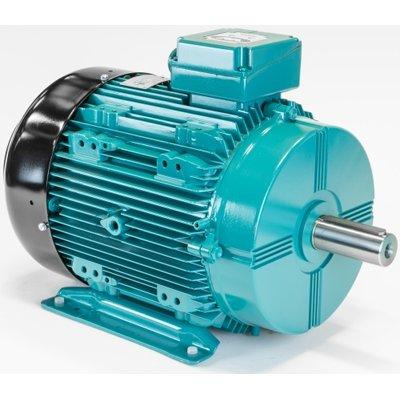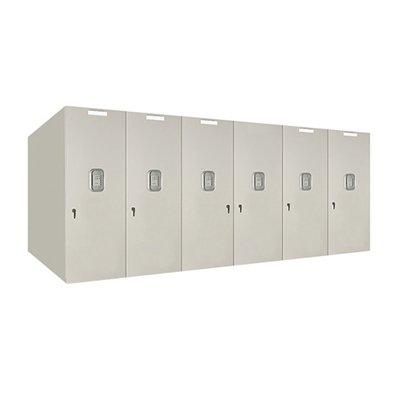The entire transportation sector is undergoing a radical transformation, with internal combustion engine (ICE) vehicles gradually giving way to less polluting electric and hybrid cars and cleaner mass transportation solutions (trains, aircraft, and ships).
Solutions capable of maximizing efficiency and reducing environmental impact are needed to contain greenhouse gases (GHG) emissions and mitigate global warming.
Wide bandgap (WBG) semiconductors
Wide bandgap (WBG) semiconductors exhibit several properties that make them attractive for transportation applications.
Their usage can result in more efficient, faster, and lightweight vehicles with improved range and reduced environmental impact.
Properties of WBG materials
While silicon has a bandgap of 1.1 electronvolts (eV), WBG materials have a bandgap of 2 to 4 eV
Wide bandgap materials are quickly transforming the power electronics area due to their advantages over commonly used silicon (Si). While silicon has a bandgap of 1.1 electronvolts (eV), WBG materials have a bandgap of 2 to 4 eV.
Additionally, the breakdown electric field of most WBG semiconductors is substantially higher than silicon. That means they can operate at significantly higher temperatures and voltages, providing higher power levels and lower losses.
The main advantages of SiC power devices, compared to silicon-based counterparts, are the following:
- Low switching losses: SiC MOSFETs are unipolar devices that exhibit very low turn-on and turn-off switching losses. This property enables higher switching frequencies with lower losses, allowing the reduction of passive components and magnetics.
- Low conduction losses: Due to the absence of a bipolar junction, SiC devices can also reduce losses during light-load or partial-load operation.
- High operating temperatures: Silicon carbide offers superior thermal properties compared to silicon. SiC exhibits low leakage currents over a wide range of temperatures, allowing operation beyond 200°C. Simplified cooling and excellent thermal management are a consequence of this property.
- Intrinsic body diode: Thanks to this characteristic, SiC MOSFETs can operate in diode mode in the third quadrant providing excellent performance in power applications.
Obtaining SiC devices with higher power density, efficiency
Combining the above properties allows obtaining SiC devices with higher power density, efficiency, operational frequencies, and smaller footprint.
The main advantages of GaN power devices, compared to Si and SiC counterparts, are the following:
- GaN devices can operate in the third quadrant without reverse recovery charge even though they do not have an intrinsic body diode. As a result, there is no need for an anti-parallel diode.
- Low gate charge QG and on-resistance RDS (ON), which translate into lower drive losses and faster switching rates.
- Zero reverse recovery, resulting in lower switching losses and less EMI noise.
- High dv/dt: GaN can switch at very high frequencies and has 4x faster turn-on and 2x faster turn-off than SiC MOSFETs with similar RDS (ON).
Applications of WBG devices
Often, GaN devices are the best choice for high-frequency applications
There are applications where SiC and GaN offer the best performance and others where their characteristics overlap those of silicon.
Often, GaN devices are the best choice for high-frequency applications, whereas SiC devices have high potential at high voltages.
Hybrid and electric vehicles
H/EVs use several power electronics systems to transform grid or engine energy into a form suitable for powering motor and auxiliary devices. Most H/EVs also use regenerative braking, in which the wheels rotate the generator to charge the battery.
The traction inverter is a crucial component in these vehicles, converting the DC high voltage from the batteries into AC for powering the three-phase motor. Due to the high power involved, SiC devices are preferred in this application, with a rating of 650 V or 1.2 kV, depending on the topology of the inverter. SiC helps reduce losses, size, and weight, allowing solutions with small form factors.
Onboard charger (OBC) connects to the grid
The onboard charger (OBC) connects to the grid, converting AC into DC voltage to charge the battery. OBC output power is usually between 3.3 kW and 22 kW and relies on high voltage (600 V and above) power devices.
While both SiC and GaN are suitable for this application, GaN’s features, like high switching frequency, low conduction losses, and reduced weight and size, make it the ideal solution for implementing OBCs.
Low-voltage (LV) DC-DC converter
Another application of WBG in H/EVs is the low-voltage (LV) DC-DC converter
Another application of WBG in H/EVs is the low-voltage (LV) DC-DC converter, responsible for stepping down the battery voltage (200 V in HEVs, above 400 V in EVs) to the 12 V/48 V DC voltage that is required for powering the auxiliary systems.
Featuring a typical power of less than 1 kW, the low-voltage (LV) converter can achieve higher frequencies using GaN and SiC devices.
Rail transportation
Electric trains draw power from the grid via a catenary line or a third rail, converting it into a form suitable for the motors and the auxiliary systems. If the train operates on an AC line, a transformer and rectifier must step down and condition the voltage to DC. The DC voltage is then split and delivered through inverters to address the needs of the auxiliary and traction systems.
The traction inverter transforms DC into AC for powering the motors and reconditions the electricity produced by regenerative braking. Therefore, this converter is designed to run a bidirectional flow of energy. Instead, the auxiliary inverter supplies power for cooling systems, passenger comfort, and other non-movement-related needs.
The size of the power electronics within the traction inverter depends on the class of train:
- Transit trains: 1.2 kV to 2.5 kV
- Commuter trains: 1.7 kV to 3.3 kV
- Intercity trains: above 3.3 kV
Regenerative braking
Regenerated energy must be stored or used immediately; otherwise, it is lost
However, most trains use either 3.3 kV or 1.7 kV. Regenerative braking, which returns a part of the electricity to the local grid, rail power distribution system, or energy storage, makes the system more complicated than those in the previously stated applications. Regenerated energy must be stored or used immediately; otherwise, it is lost.
Bipolar Si-based IGBTs and freewheeling diodes, traditionally used in power modules for railway traction applications, can be replaced by unipolar SiC-based MOSFETs and diodes, thus increasing the switching frequency and power density.
Conduction and switching losses must be decreased
Conduction and switching losses must be decreased, and the maximum junction temperature must be raised to reduce the weight and volume of the power electronic equipment used in railway traction applications.
For the widely used bipolar silicon power devices, increasing conduction losses and decreasing switching losses have the opposite effects. A unipolar device does not experience the trade-off between the conduction and switching losses, as bipolar devices do. As a result, switching losses could be reduced, while minimizing conduction losses.
WBG power electronics helps reduce power losses
Power losses in the electric rail can be drastically reduced with WBG power electronics. As a result, less energy will be drawn from the grid, and more will be returned via regenerative braking. WBG devices also offer additional benefits that considerably help rail transportation in addition to efficiency increases, such as:
- Reduced weight has significant impacts on efficiency.
- Higher operating temperature allows for a smaller cooling system.
- Increased switching frequency enables smaller passive dimensions, which lowers the weight of the traction and auxiliary inverters. The inverter and motor can respond to variations in demand more quickly thanks to the higher switching frequency, thus boosting efficiency. Finally, since the higher frequency is less audible and cooling fans may be turned off, railway stops would be less noisy when trains are present.
Marine and aviation applications
Power electronics innovations have benefited the marine sector for a long time
Power electronics innovations have benefited the marine sector for a long time. On the ship, medium voltage AC level electricity from synchronous generators powered by diesel engines is supplied to various loads. Propulsion drives (a mixture of AC-DC and DC-AC converters) and other loads are primarily among them.
Recent trends in the marine sector are trying to replace AC electrical distribution networks with DC distribution networks. This solution removes the need to synchronize the generators to the AC power distribution, provided they can operate at variable speeds, and achieves fuel savings. On the other hand, it requires the introduction of rectifier circuits (AC-DC converters) between AC generators and the DC power distribution network.
Marine propulsion variable speed drives
Marine propulsion variable speed drives are crucial ship components that must operate with extreme reliability. They are frequently rated from a few watts to a few tens of megawatts. Often, these drives are the most significant power conversion blocks in a ship with AC electrical power distribution. Hence their great efficiency is crucial.
Once more, conventional silicon-based power devices are being replaced by SiC and GaN devices, which increase efficiency while reducing size and weight. WBG devices will soon overtake Si-based devices as the industry leader, bringing cutting-edge power electronics system solutions that are impossible with silicon technology.
Future fuel-turbine-powered electrical generators
Future fuel-turbine-powered electrical generators will be the prime mover for hybrid and all-electric avionic propulsion systems. Power electronics will subsequently be used to connect the generator and motor. Very high DC voltage buses are necessary to ensure enough power can be available. These buses can range in voltage from a few kVs for light vehicles to the MV range for airplanes.
Moreover, a high DC voltage bus makes it possible to use permanent magnet synchronous machines as generators, which lowers reactive power and the power electronics' rating. The power converters need equipment that can function at high switching frequencies, due to the fast generator rotational speed, which results in smaller and lighter filter elements.
Silicon carbide
Silicon carbide is the most promising semiconductor device to meet all requirements
Silicon carbide is the most promising semiconductor device to meet all requirements, while ensuring high conversion efficiency.
For aircraft in the lower power range, newly created 3.3 kV and 6.5 kV SiC MOSFET devices are of significant interest. They can also be employed in modular power converter topologies to meet larger aircraft's higher voltage/power requirements.
Conclusion
Wide bandgap semiconductors, such as silicon carbide (SiC) and gallium nitride (GaN), offer several advantages over traditional semiconductors in their ability to handle high voltages and temperatures with lower power loss. These characteristics make them particularly well-suited for power electronics used in various applications, including transportation.
WBG semiconductors are used in the transportation industry to develop more efficient and reliable electric and hybrid vehicles. The lower power loss of wide bandgap semiconductors allows higher switching frequencies, reducing power electronics' size and weight. This, in turn, can result in greater vehicle range, faster charging times, and improved overall performance.
Development of efficient powertrains
Wide bandgap semiconductors also enable the development of more compact and efficient powertrains, including motor drives and inverters for EVs and HEVs. By reducing the size and weight of these components, vehicle designers can free up space for other components or improve the vehicle’s overall aerodynamics.
In addition to electric and hybrid electric vehicles, wide bandgap semiconductors are also used in other transportation forms, such as airplanes and trains. In these applications, the high temperature and high voltage capabilities of wide bandgap semiconductors can improve the efficiency and reliability of power electronics, leading to reduced operating costs and improved safety.












